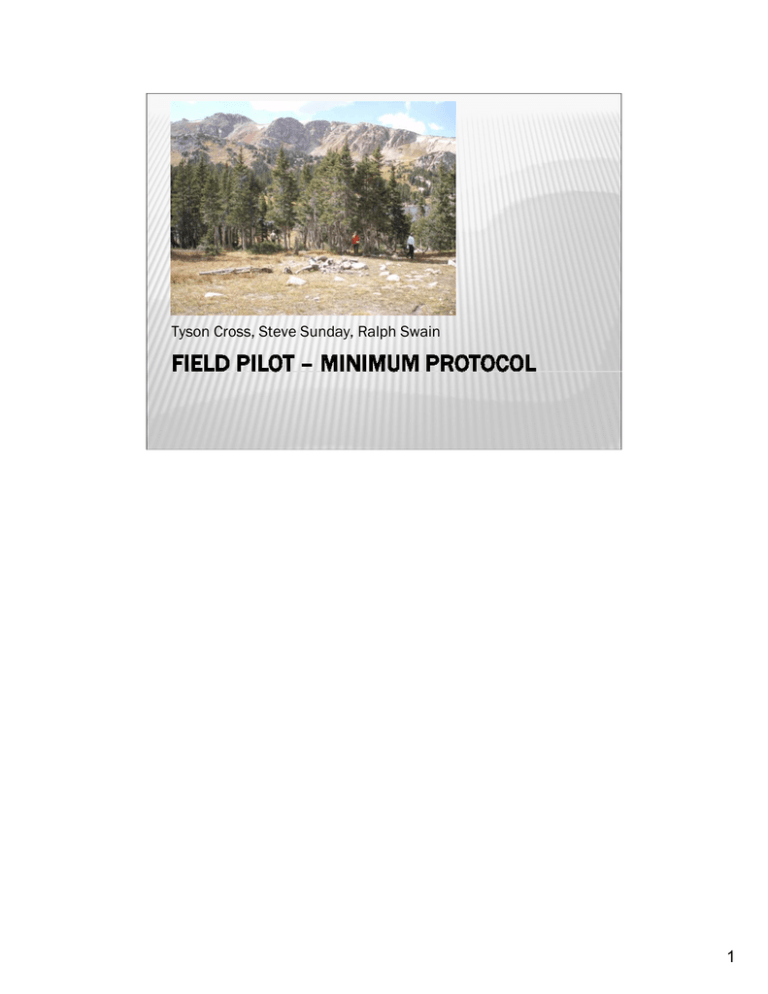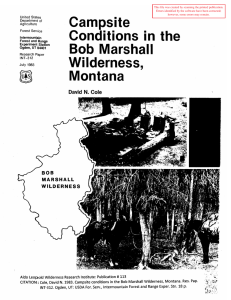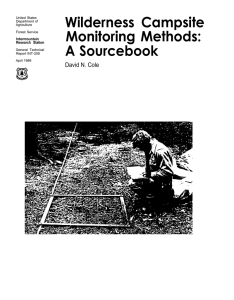1 Tyson Cross, Steve Sunday, Ralph Swain
advertisement

Tyson Cross, Steve Sunday, Ralph Swain 1 ´ Don’t do too much « Allow 3 to 4 Minutes per site « Rapid assessment allows for more time searching out new sites to complete the census portion of Element 6 2 GPS coordinates, photo-points and maps are important for finding new sites ´ Route planning is critical ´ GPS, Photo-points and maps This is of greater importance when the person who completed the original campsite inventories is not available. Whenever possible, completion of inventories should be done consistently by the same person. This is often not possible, and new evaluators will have a difficult time being confident that they are in the correct site. GPS points have an error associated with them, and new sites may appear every summer. Route Planning Good route planning will allow an evaluator to efficiently visit existing sites and simultaneously search for new sites. Keep in mind that previous inventories were probably not done as a census, but rather a measure of popular or heavily impacted areas. 3 The distinction between an inventory and a census is important ´ Search for all possible campsites ´ Inventory vs. Census The distinction between an inventory and a census is critical. In order to complete the census, 95% of possible sites need to be found. In order to accomplish this, tracking and recording your steps is important. I personally leave the GPS unit on, and then plot my tracks in order to see if I visited all of the possible areas. Also, route planning is, again, important in order to complete a census. Finding Possible Sites To do this, look for sites near water, level spots, (benches) and follow social trails to possible campsite locations. It is important to be diligent and thorough in exploring drainages. It helps to formulate and adapt a solid plan for checking all possible areas. After a day in the field review the work you have done and create a route plan for the next day. Take into account the difficulties of steep off trail hiking. Plan a route that will allow you to check all likely areas without retracing your steps to much. If two people are working on the inventory together, they should fan out but stay in eye sight of each other. Finding level 1 campsites can be tricky. 4 Notes: Home | Customer Service | Technical Support | About DeLorme Copyright © DeLorme. Latitude 43°48.491' North, Longitude 70°09.844' West Route planning Make sure to track your route in order to avoid inventorying the same place twice and to make sure that all areas are inventoried. The map above shows my GPS “Tracks” as I inventoried the Lost Creek Wilderness. In the field I would leave my GPS unit on, then download my tracks in order to keep track of the area I had inventoried. Another way to keep track of the area you inventory is to encompass and hatch mark the area you inventory on a topo-map. 5 A consistent protocol for numbering sites is critical R2 will use the following: Wilderness – 3 digit number (Infra-Wild) Trail – 4 digit number Campsite – 3 digit number Numbering Campsites Trail numbers are used in forest travel management 6 Complete minimum protocol site information sheet using NAD 83 and UTM coordinates ´ Take a macro photo of site information sheet ´ Take a landscape picture of site ´ NAD 83 Using the correct units is critical. If the map Datum is not NAD 83, the GPS points will not interface correctly with the computer software, and relocating the points will be difficult. NAD 83 is usually not the default datum for your GPS Unit. Please make sure you are using the correct datum every time you enter the field. Pictures of sites Site photos should be shot from approximately 20 ft. away from fire ring or center of activity. Try to show a landmark such as a boulder or clump of trees. Take an azimuth and pace to the known object. Try to keep good notes so that people can return to the site. It is a good idea to shoot the photo with your back to the trail and lens to the campsite. 7 8 If you take more than one photo, make sure to take good field notes in order to indicate the number of photos and distance 9 Review Campsite monitoring procedures by David Cole ´ Evaluate groundcover loss relative to surrounding area ´ Document site recovery in tracking notes ´ Campsite monitoring procedures David Cole has outlined, in detail, the procedures for the Minimum Protocol for Campsite Monitoring. This document is rich in information and contains all of the necessary information for completing these inventories. The document is rich in information. Read the document several times and refer to it often. 10 11 12 What counts as “severe” tree damage can be difficult to evaluate ´ Special situation: Krumholtz ´ Severe tree damage What counts as a severely damaged tree can be difficult to determine. Again, reading through David Cole’s Monitoring Procedures will help. Concentrate on human damage, and what can be considered human damage. Look for trees that have hatchet marks, girdling, root damage from compaction and erosion, and unnaturally felled trees. Krumholtz Krumholtz, a German term meaning “crooked wood” can be found at high elevations in the central Rockies. These trees are usually dwarfed sub-alpine firs or Engelmann spruce trees. The standard according to the Monitoring Procedures is to count trees that have been cut down only if they are larger than 4 inches. In Krumholtz stands it may be appropriate to count smaller trees as being severely damaged. 13 The tree on the left does not have 1 square foot of damage, so unless there is more damage to the tree elsewhere, it does not qualify as a severely damaged tree. It is important to use the written definitions of damage, and not a personal evaluation. The tree on the right looks like natural damage. Unless there are marks that seem as though they are caused by humans (hatchet marks etc.) then the tree should not be counted. If marks were present on this tree, it would count because there is more than a square foot of damage. 14 Severe damage 15 I was able to count over 50 rings on this tree that was 2 inches wide 16 Measure out a 16’ x 16’ area to mentally calculate 255 sq. ft. ´ What is “normal” for a given area? ´ Normality In order to better determine what counts as the disturbed area, it is a good idea to examine what is normal in a given area. This can be tricky, so spend some time looking around in order to get a good idea of the micro ecosystems around you 17 Lodgepole Pine and other areas with little ground cover ´ Pinion-juniper cover type ´ Loge pole Loge pole pine is often considered the “desert of the forest” ecosystem. Vegetation can be sparse in the loge pole pine ecosystems. Again, refer to the special situations section of the Monitoring Procedures in order to better grasp what to do in these situations Pinion-juniper cover type Clues such as bare mineral vs. leaf litter, and even the flatness of the soil in the area are important indicators. In pinion-juniper areas, look for damage to cryptobiotic (living) soils. 18 19 20 Lean to’s Lean-to’s are recorded with the minimum protocol work if there are signs of camping. If there are trees cut down around them, or a fire ring then they may be counted. They may be counted with a more involved protocol. 21 22 23




